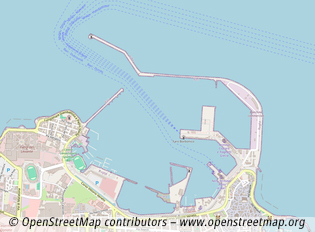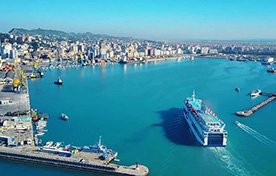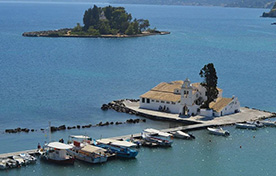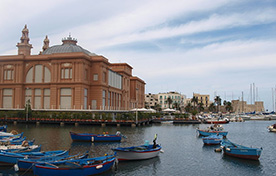
The Map Data comes from OpenStreetMap contributors. It is available under the Open Database License (ODbL) .
Bari: Puglia's Dynamic Capital and Adriatic Crossroads
Bari, the vibrant capital of Italy's Puglia region, is a city of compelling contrasts and boundless energy. It's where the ancient, labyrinthine alleyways of Bari Vecchia (Old Bari) meet the elegant grid layout of the 19th-century Murat district; where deep-rooted traditions coexist with modern dynamism; and where the Adriatic Sea shapes life, culture, and commerce. More than just Puglia's administrative and economic heart, Bari is a major Mediterranean port city, acting as a crucial gateway connecting Italy with Greece, Albania, Croatia, and beyond. Whether you're arriving on a ferry from Igoumenitsa, Durres, or Dubrovnik, flying into its international airport, or travelling overland, Bari offers a rich tapestry of history, culture, stunning architecture, and mouth-watering cuisine. This guide provides essential tourist information for Bari to help you discover this fascinating Southern Italian hub.
Where is Bari Located?
Bari holds a prominent position on the Adriatic coast of Southern Italy. It is the capital of both the Puglia region (Apulia) and the Metropolitan City of Bari. Situated roughly midway between the Gargano Peninsula to the north and the Salento Peninsula (where Brindisi lies) to the south, Bari possesses one of the most important harbours on the Adriatic. Its strategic coastal location has historically made it a vital commercial centre and a bridge between Western Europe and the Eastern Mediterranean/Balkans, a role strongly reflected in its extensive ferry network.
A Tapestry of Time: Bari's History and Heritage
While Bari's origins trace back to the ancient Peucetians and later became the Roman municipality of Barium, its golden age truly began in the early medieval period. Unlike cities famed primarily for classical ruins, Bari's historical heart beats strongest in its medieval and Romanesque heritage.
- Byzantine and Norman Influence: Bari was a significant Byzantine stronghold before being conquered by the Normans in the 11th century. This period left an indelible mark on the city's architecture and importance.
- The Arrival of Saint Nicholas: A pivotal moment in Bari's history occurred in 1087 when sailors brought the relics of Saint Nicholas (the beloved figure behind Santa Claus) from Myra (modern-day Turkey) to Bari. This event transformed the city into a major pilgrimage destination for both Roman Catholics and Orthodox Christians, bridging East and West. The magnificent Basilica di San Nicola was built to house these precious relics.
- Medieval Centre (Bari Vecchia): The old town is a living museum. Its dense, maze-like layout, designed for defence and shade, preserves its medieval character. While specific "ancient ruins" like Roman forums are less prominent than in other cities, the entire district, enclosed by fortified walls, speaks volumes of its past. Key historical buildings like the Basilica, Cathedral, and Castle are nestled within this atmospheric quarter.
- Archaeological Hints: While not the main draw, archaeological excavations sometimes reveal glimpses of Roman Barium, particularly beneath the Cathedral and in designated archaeological areas like the one near Piazza del Ferrarese, showcasing parts of the ancient Via Traiana. The Museo Archeologico di Santa Scolastica complex offers insights into the region's deeper past.
Bari's heritage is less about grand classical monuments and more about its powerful Romanesque churches, imposing castle, and the incredibly preserved medieval urban fabric of Bari Vecchia.
Discovering Bari: Top Attractions and Experiences
Bari offers a wealth of sights and experiences, blending history, culture, and seaside charm.
- Bari Vecchia (Old Bari): Lose yourself in the enchanting labyrinth of narrow, winding streets and small squares. This walled medieval quarter is the soul of Bari. Observe local life unfold: residents chatting, laundry hanging overhead, and importantly, the famous signore sitting outside their homes skilfully making orecchiette, Puglia's signature pasta. Don't miss key spots like Piazza Mercantile (historic commercial heart with the Column of Justice) and Piazza del Ferrarese (gateway to the old town near the sea).
- Basilica di San Nicola: A masterpiece of Apulian Romanesque architecture and one of Southern Italy's most important religious sites. Founded in 1087, its solid, fortress-like exterior contrasts with a luminous interior. Admire the intricate stonework, the stunning ciborium (altar canopy), and the precious 12th-century episcopal throne (Cathedra of Elia). Descend to the crypt to visit the tomb of Saint Nicholas, a powerful spiritual site attracting pilgrims worldwide.
- Castello Normanno-Svevo (Norman-Swabian Castle): Dominating the edge of Bari Vecchia, this formidable fortress showcases layers of history. Originally built by the Normans in the 12th century, it was destroyed and then rebuilt by Holy Roman Emperor Frederick II in the 1230s. Walk the ramparts, explore its courtyards, and visit the Gipsoteca (plaster cast museum) housed within. Its sheer scale and position are impressive.
- Cattedrale di San Sabino (Bari Cathedral): Bari's official cathedral, dedicated to Saint Sabinus, is another magnificent example of Apulian Romanesque style, built in the late 12th/early 13th century. While perhaps slightly less famous than San Nicola, it boasts a beautiful rose window, an ornate interior, and an atmospheric crypt containing ancient mosaics and Roman elements.
- Lungomare Nazario Sauro / Lungomare Imperatore Augusto: Bari boasts one of Italy's longest and most attractive seafront promenades. Perfect for walking, jogging, or simply enjoying the sea views, it stretches from the modern city around Bari Vecchia towards the port. Admire the elegant architecture lining the promenade and the bustling fishing harbour (Molo San Nicola).
- Teatro Petruzzelli: Rebuilt after a fire, this opulent theatre is a major cultural landmark and one of Italy's most prestigious opera houses. Check its schedule for performances or simply admire its grand facade.
- Murattiano District (Modern Bari): Contrast the old town with the planned 19th-century district, named after Joachim Murat, Napoleon's brother-in-law. Characterized by its grid layout, wide streets, and elegant buildings, it's the city's main commercial hub, particularly along Via Sparano, Bari's premier shopping street.
Sun and Sea: Beaches In and Around Bari
While Bari is a major city, beach options are readily available.
- Pane e Pomodoro Beach: Bari's city beach, located south of the centre. It's a sandy stretch popular with locals, easily accessible, and offers basic facilities. While convenient, water quality can sometimes be variable due to its urban proximity.
- Polignano a Mare: Just a short train ride (around 30 minutes) south of Bari, this famously picturesque town perched on limestone cliffs offers stunning sea views and small, pebbly beaches like the iconic Lama Monachile, nestled in a cove beneath the town. A must-visit day trip.
- Monopoli: Slightly further south than Polignano, Monopoli offers longer sandy beaches and numerous coves (calette) with clear water, both free areas and private lidos (beach clubs).
- North of Bari: Beaches like Giovinazzo or Molfetta offer alternative coastal spots accessible by train or car.
For the best beach experiences, venturing slightly outside the city centre yields beautiful Puglian coastline.
A Culinary Journey: The Flavours of Bari
Bari is a food lover's paradise, showcasing some of Puglia's most iconic dishes. The focus is on simple, high-quality ingredients from both land and sea.
- Orecchiette: The 'little ear' pasta reigns supreme. In Bari Vecchia, particularly on Arco Basso street, you can watch women making it by hand daily. Traditionally served with cima di rapa (turnip greens) or a rich meat ragù.
- Focaccia Barese: A local obsession. This delicious focaccia is typically topped with cherry tomatoes, olives, oregano, and generous amounts of local olive oil. Find it in bakeries (panifici) all over the city.
- Tiella di Riso, Patate e Cozze: A unique and flavourful baked dish layering rice, potatoes, mussels, onions, and tomatoes. A true Bari comfort food classic.
- Crudo di Mare: Bari is famous for its tradition of eating raw seafood. At the old port's fish market (N'derr la lanz), you can see fishermen selling (and locals eating) raw mussels, clams, sea urchins (ricci di mare), squid, and octopus. Consume with caution from reputable sources.
- Polpo (Octopus): Often served grilled (alla griglia) or in salads.
- Street Food: Try sgagliozze (squares of fried polenta) and popizze (small fried dough balls), often sold hot from street vendors in Bari Vecchia. Also look for panzerotti (fried turnovers filled with tomato and mozzarella).
- Burrata and Cheeses: Enjoy creamy burrata, mozzarella, and other local Puglian cheeses.
- Wines: Pair your meals with local wines like Primitivo, Negroamaro, or Bombino Nero (rosé).
Explore the trattorias in Bari Vecchia, seafood restaurants near the port, and bakeries for an authentic taste of Bari.
Entertainment, Nightlife, and Local Vibe
Bari offers a lively atmosphere, especially in the evenings and on weekends.
- Bari Vecchia Buzz: The old town comes alive at night, with numerous small bars (localini), pubs, and trattorias filling the piazzas and alleyways. Piazza Mercantile and Piazza del Ferrarese are key gathering spots.
- Aperitivo Culture: Join the locals for the pre-dinner aperitivo ritual – drinks accompanied by complimentary snacks – at bars in both the old town and the Murattiano district.
- Passeggiata: The evening stroll along the Lungomare or through the main shopping streets (like Via Sparano) is a popular social activity.
- Markets: Experience local life at the bustling fish market near the Teatro Margherita or explore food markets for fresh produce.
- Festivals: Bari's most important festival is the Festa di San Nicola, celebrated twice a year: in early May (commemorating the arrival of the relics, with a historical procession and sea parade) and on December 6th (the liturgical feast day). These are major events attracting large crowds.
Bari's nightlife is more about socializing in atmospheric squares and enjoying food and drink rather than large nightclubs, though options exist.
Finding Your Base: Accommodation in Bari
Bari provides a wide array of accommodation choices.
- Hotels: Numerous hotels are available, ranging from budget-friendly options near the train station (Bari Centrale) and port, convenient for travellers, to more upscale hotels in the Murattiano district offering comfort and proximity to shopping.
- B&Bs and Guesthouses: Bari Vecchia is packed with charming Bed & Breakfasts and guesthouses (affittacamere) tucked away in historic buildings. Staying here offers an immersive experience but might involve navigating narrow streets and stairs.
- Apartments: Renting an apartment provides flexibility, especially for families or longer stays. Options are available in both the old and new parts of the city.
Consider your priorities: convenience for transport (station/port), immersion in history (Bari Vecchia), or proximity to modern amenities and shopping (Murattiano).
How to Get to Bari: Your Transport Guide
Bari is exceptionally well-connected.
- By Ferry: The Port of Bari is one of Italy's premier passenger ports with extensive international connections. It's a major hub for ferries to and from Greece (Igoumenitsa, Patras, Corfu, sometimes Zakynthos/Kefalonia seasonally), Albania (Durres), and Croatia (Dubrovnik, Split - mainly seasonal). Several reputable ferry companies operate these routes, offering daily or frequent sailings, including comfortable overnight options with cabins. Arriving by ferry provides dramatic views of the city and port. Booking your Bari ferry tickets well in advance, particularly during summer, is crucial. Platforms like ferries.gr offer a convenient way to compare routes, schedules, and prices and secure your booking.
- By Air: Bari Karol Wojtyła Airport (BRI) is a modern international airport located about 8 km northwest of the city centre. It has excellent connections with numerous Italian and European cities, served by both flag carriers (like ITA Airways) and low-cost airlines (like Ryanair, EasyJet, Wizz Air). The airport is efficiently connected to the city centre and Bari Centrale train station via a dedicated Metro line (FM2) and shuttle buses.
- By Train: Bari Centrale is a major railway hub in Southern Italy. Trenitalia offers frequent services, including high-speed Frecciarossa/Frecciargento trains connecting Bari to Rome, Milan, Bologna, Venice, and other major Italian cities, as well as regional trains serving Puglia (Lecce, Brindisi, Foggia, Taranto) and neighbouring regions. Several private regional lines (e.g., Ferrovie Appulo Lucane, Ferrotramviaria) also operate from or near Bari Centrale.
- By Car: Bari is easily accessible via the Italian motorway network. The A14 Autostrada Adriatica runs north-south along the coast, connecting Bari with Bologna and Taranto. The SS16 also follows the coast, while other state roads connect inland. Driving is ideal if you plan to explore the wider Puglia region.
The Port of Bari: Your Adriatic Sea Connection
The Porto di Bari is vast and vital, handling significant passenger and freight traffic.
- Location & Structure: The port area stretches along the coast northwest of Bari Vecchia. The main passenger terminal (Terminal Crociere / Stazione Marittima) is located here, easily accessible from the city ring road (tangenziale) and with connections to the train station and airport.
- Facilities: The passenger terminal offers check-in desks for the various ferry companies, waiting areas, cafes, information points, and customs/security services. Ample parking is available nearby.
- Key Ferry Routes: Bari's strength lies in its diverse international ferry connections:
- Greece: Igoumenitsa (daily, year-round), Patras (frequent, year-round), Corfu (frequent, seasonal focus), other Ionian islands like Zakynthos & Kefalonia (less frequent, seasonal).
- Albania: Durres (multiple daily sailings, year-round).
- Croatia: Dubrovnik (seasonal, several times a week), Split (less frequent, seasonal).
- Montenegro: Bar (check seasonality and operator availability).
Booking Ferries: Use ferries.gr to easily search for Bari ferry routes, compare ship amenities (cabins, seating, garage space), check timetables, and book your journey seamlessly.
The Port of Bari provides an efficient and convenient link between Italy and several Balkan countries, making it a preferred choice for many travellers.
The website www.Ferries.gr is the perfect way to find information on all ferry routes from / To Bari. You can search for routes based on the date of departure and destination, and learn about all the companies that depart and the prices of tickets.













